The Global Fiber Reinforced Concrete Market is estimated to be valued at USD 2.86 Bn in 2025 and is expected to reach USD 4.59 Bn by 2032, exhibiting a compound annual growth rate (CAGR) of 7.0% from 2025 to 2032.
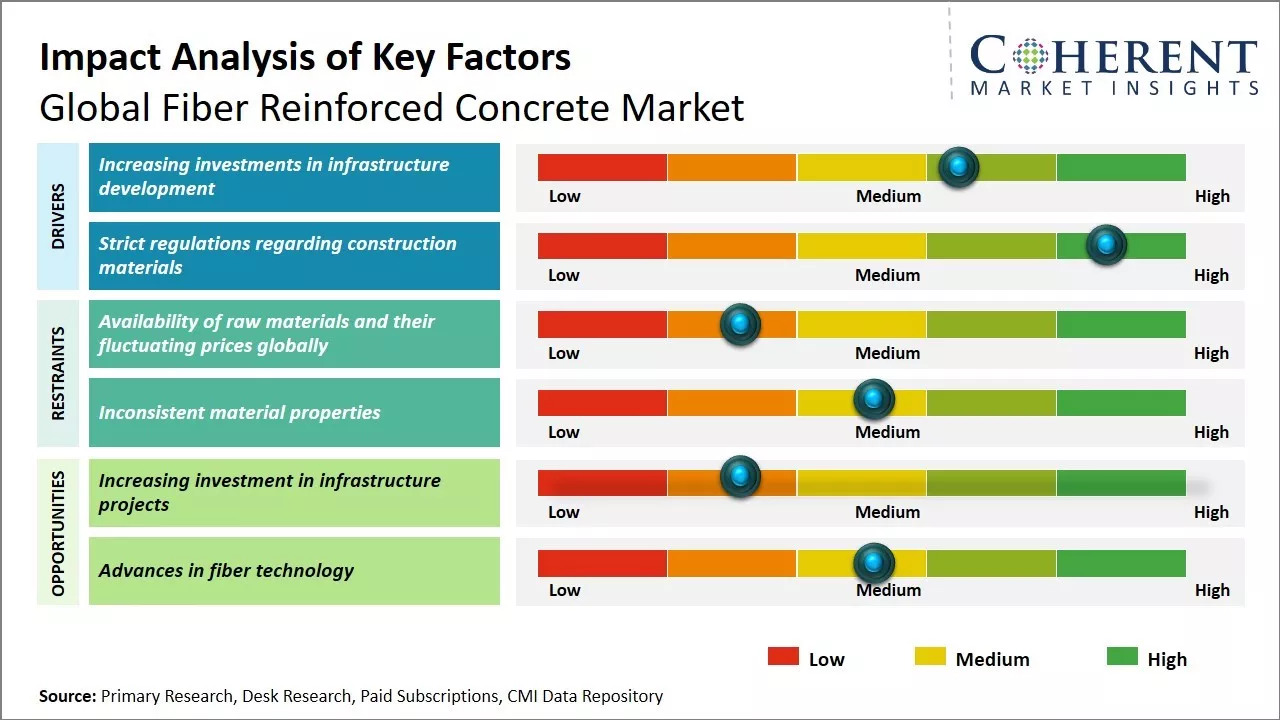
Discover market dynamics shaping the industry: Request sample copy
The fiber reinforced concrete market is expected to witness significant growth over the forecast period. This can be attributed to increasing construction activities across both commercial and residential sectors. Fiber reinforced concrete offers benefits like higher strength, flexibility, and durability. The material is widely being adopted in applications like driveways, sidewalks, foundations, and bridges where high strength and crack resistance is required. Growth in infrastructure development projects in developing nations will further provide opportunities for fiber reinforced concrete market. Additionally, government support through initiatives to promote the use of sustainable construction materials will also contribute to the positive market outlook.
Increasing investments in infrastructure development
With rapid urbanization and growing population across both developed and developing economies, there has been a significant rise in infrastructure development activities globally over the past few decades. Governments around the world have been ramping up investments towards building robust transportation networks such as roads, bridges, railways, etc. to support the communication needs. Fiber reinforced concrete is increasingly being used in infrastructure construction projects owing to its versatility and ability to improve the strength, durability and sustainability of structures. Some of the key advantages it offers include higher tensile strength, crack and corrosion resistance, reduction in dead weight and longevity. Various infrastructure giants and civil construction companies have been favoring fiber reinforced concrete over conventional concrete for building large concrete structures that need to withstand heavy loads and harsh weather conditions for many decades. The material is suitable for constructing long-lasting highways, urban transit systems, tunnels, parking structures, industrial floors and airport runways. With growing infrastructure investments in developing economies of Asia Pacific and Latin America, and redevelopment activities in Europe and North America, the demand for advanced concrete materials like fiber reinforced concrete is expected to rise substantially in the coming years.
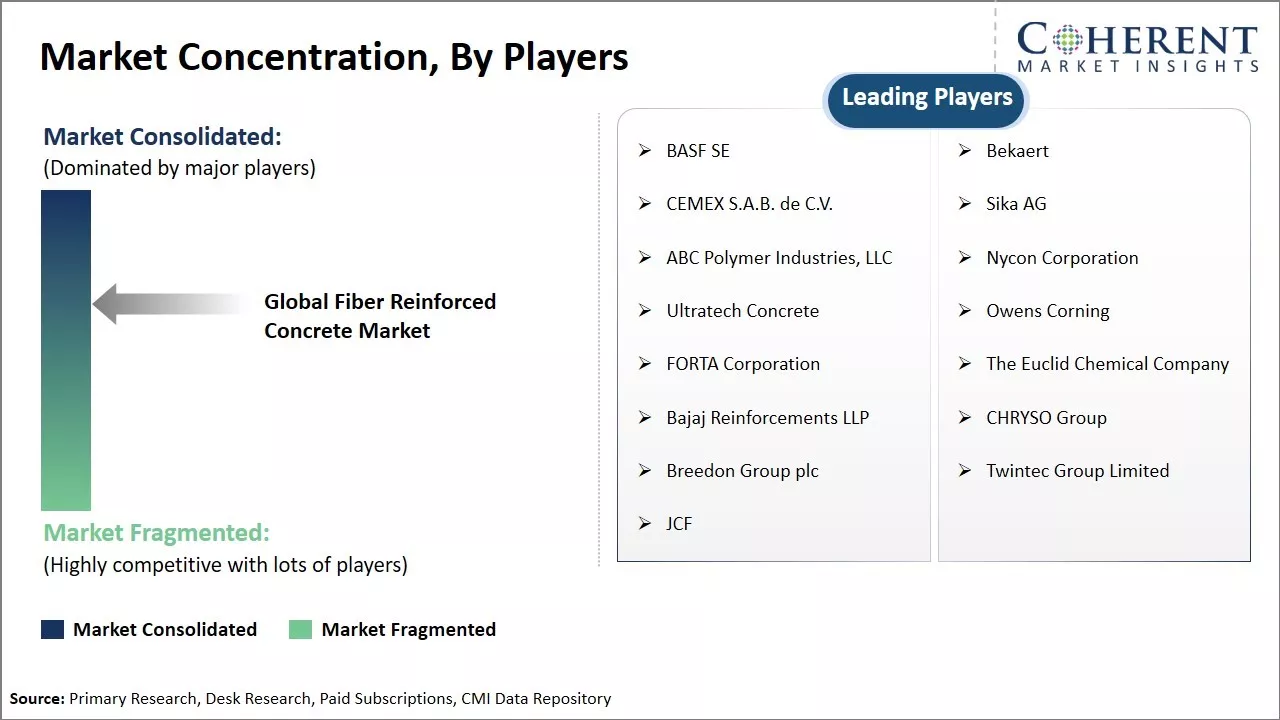
Get actionable strategies to beat competition: Request sample copy
Strict regulations regarding construction materialsStrict regulations regarding the use of construction materials in developed countries are propelling the global fiber reinforced concrete market forward. Governments across regions like Europe, North America, and Australia have implemented stringent norms mandating the use of more sustainable and eco-friendly materials in infrastructure and building projects. Fiber reinforced concrete satisfies all the current compliance specs set by regulatory bodies as it is durable, long-lasting, and poses minimal risks to the environment during both production and disposal. The reinforcement provided by fibers allows concrete to withstand higher load levels while using less cement content. This makes fiber concrete a much "greener" alternative compared to normal concrete which requires intensive cement usage. Industries are proactively switching to fiber cement to adhere to evolving legislative outlooks favoring green materials and construction techniques. Furthermore, natural calamities due to climate change have underscored the need for disaster-proof infrastructure that can withstand extreme conditions. Fiber concrete exhibits far superior tensile strength and crack-resistance over plain cement, making structures built with it more durable and less prone to weathering or damages from seismic activities, floods, etc. After the extensive devastation caused by Hurricane Ian in Florida in 2022, government mandates now make the use of fiber concrete compulsory for public works contracting in high-risk coastal regions.
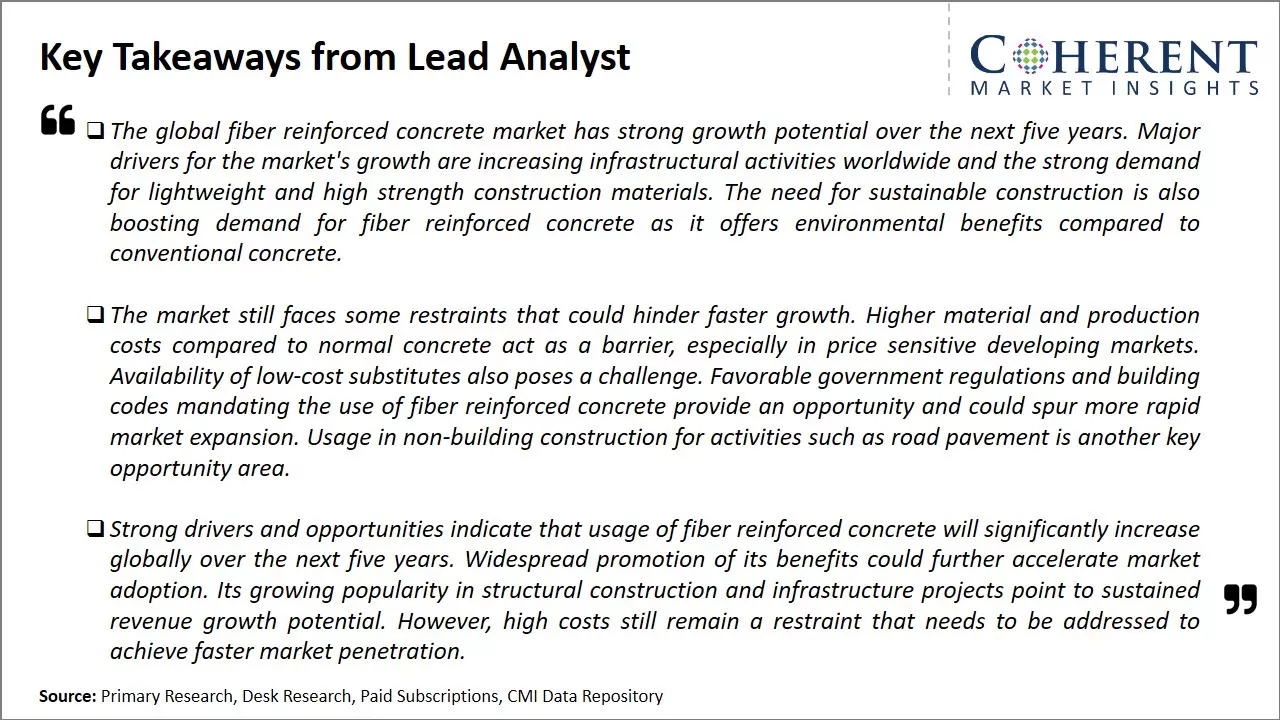
To learn more about this report, Request sample copy
Challenges: Availability of raw materials and their fluctuating prices globallyOne of the major challenges this market faces is the availability of raw materials and their fluctuating prices globally. Concrete producers need to procure fibers like steel, glass, and carbon from different sources to minimize risks. Additionally, the lack of awareness and knowledge among builders and contractors about the benefits of using fiber reinforced concrete poses another hurdle for market growth. Traditional concretes are widely used since decades and changing ways is challenging. Material inconsistency and quality issues also bring limitations.
Opportunities: Increasing investment in infrastructure projects
The market is expected to witness numerous opportunities in the coming years led by increasing investment in infrastructure projects. The need for superior infrastructure that can withstand extreme weather and last longer is driving demand. There is a rising focus on sustainable construction which will favor natural fiber reinforced concrete use.
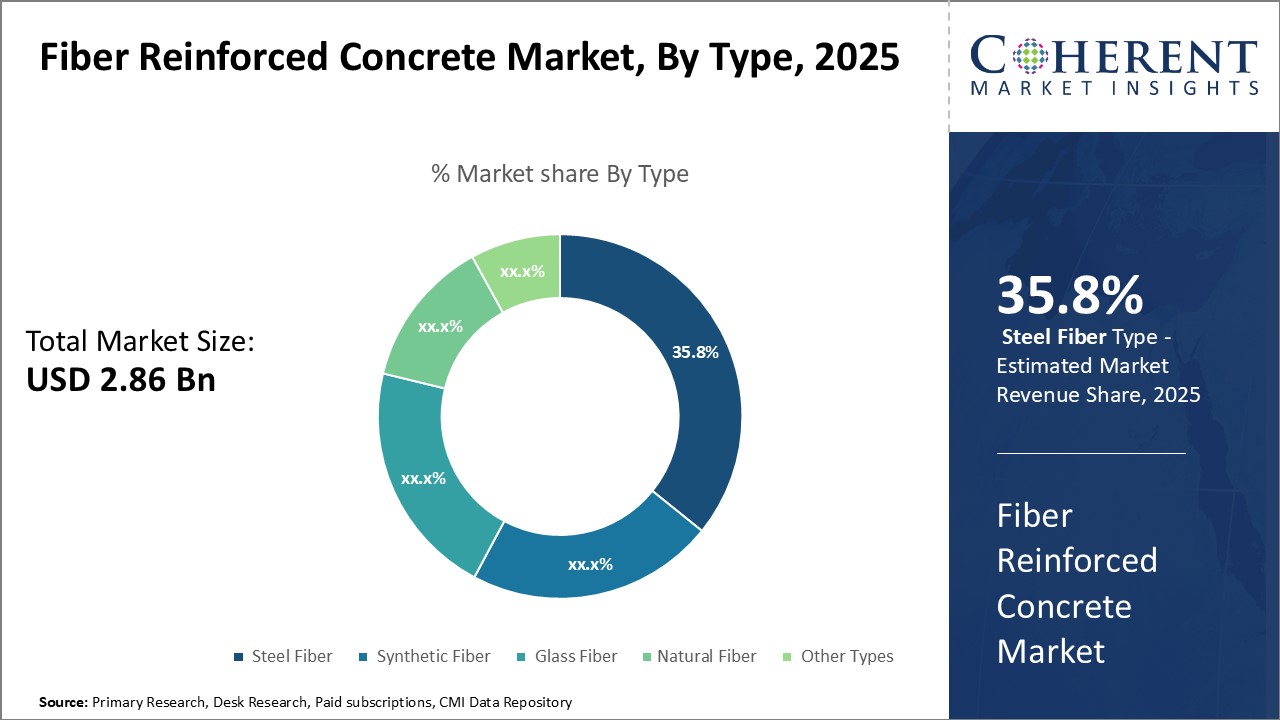
Discover high revenue pocket segments and roadmap to it: Request sample copy
Insights, By Type: Steel Fiber holds the highest share of the market owing to its superior mechanical propertiesIn terms of Type, Steel Fiber is estimated to hold 35.8% share in 2025. Steel fiber reinforced concrete (SFRC) contains short discrete lengths of steel fibers that are uniformly dispersed and randomly oriented in fresh concrete. SFRC exhibits several advantages over plain concrete such as higher residual strength, increased impact resistance, and higher ductility. These properties make steel fibers a popular choice for concrete reinforcement. The use of steel fibers helps concrete resist explosive spalling and cracking. The ductile nature of steel fibers allows them to stretch within the concrete matrix before breaking, imparting superior toughness properties. Steel fibers bridge developing cracks, thereby increasing the tensile strength of the composite material. The addition of steel fibers leads to a significant improvement in flexural strength compared to plain concrete. Several studies have shown that SFRC demonstrates higher energy absorption and impact resistance compared to concrete reinforced with other fibers. This makes steel fiber an essential material for applications requiring resistance to dynamic loads and impacts. Steel fibers are also able to control crack width and propagation in concrete structures exposed to transient loads. Given these enhanced mechanical characteristics, steel fiber reinforced concrete finds widespread use in industrial floors, airport runways, bridge decks, shotcrete construction, and other structures in harsh environments. The ability of steel fibers to prevent cracks from propagating and control crack width provides immense durability benefits. This has boosted the popularity and consumption of steel fibers in the global fiber reinforced concrete market.
Insights, by Application: Infrastructure holds the highest share of the global fiber reinforced concrete market owing to extensive ongoing infrastructure development projects
Infrastructure is estimated to hold 37.9% share of the global fiber reinforced concrete market in 2025. Infrastructure such as buildings, roads, highways, dams and tunnels requires concrete that demonstrates high residual strength, impact resistance and crack control properties. Fiber reinforced concrete answers this need excellently as fibers help concrete maintain its integrity even after the development of micro-cracks. With rapid urbanization and growing transportation infrastructure demand, many countries are undertaking massive infrastructure development projects. Mega construction activities in sectors such as transportation, energy and communications have ramped up the consumption of concrete. However, conventional concrete poses durability issues when utilized in infrastructure exposed to heavy loads and harsh external conditions. It is here that fiber reinforced concrete comes into play through its ability to improve the mechanical features and long-term performance of infrastructure concrete. Applications such as industrial floors, airport runways, bridge decks, tunnels and hydraulic structures require concrete with higher tensile strength, energy absorption capacity and crack resistance. The even dispersion of fibers makes FRC a very good fit for these duties. Fiber reinforced concrete eliminates the need for steel mesh or rebar in several simpler infrastructure elements. This provides advantages such as ease of handling, fast construction, and lower costs. Many government agencies have recognized the long-term economic and performance benefits of FRC in infrastructure. This has driven the growing preference for fiber reinforced concrete especially for new infrastructure projects.
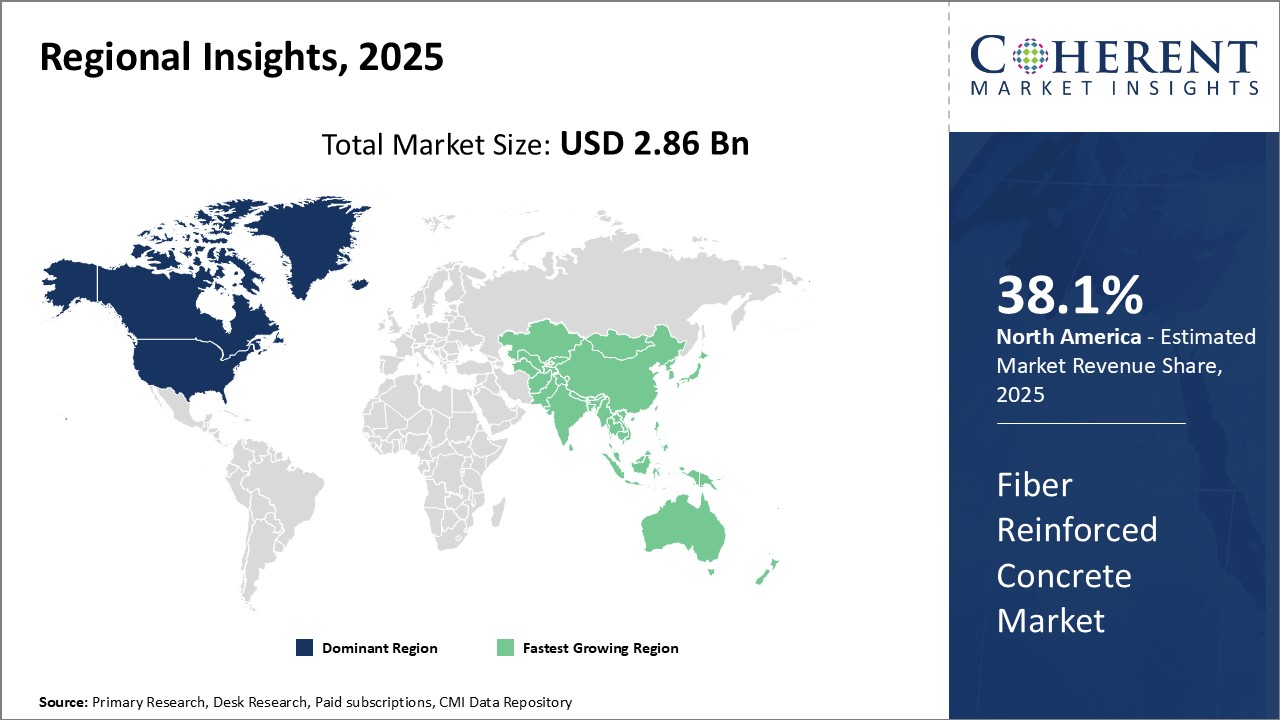
Need a Different Region or Segment? Customize now
North America has emerged as the dominant regional market for fiber reinforced concrete globally with 38.1% share in 2025. The presence of major players in the region such as BASF, W.R. Grace and Propex Concrete systems has solidified North America's leadership position. These players have established an extensive supply chain network across the U.S. and Canada to cater to the growing construction industry needs. Moreover, the fiber reinforced concrete industry receives significant support from the U.S. and Canadian governments in the form of funding for infrastructure modernization projects. This has subsequently boosted demand from both public and private construction sectors. The pricing of fiber reinforced concrete solutions in North America is also competitive owing to large production capacities of regional players and mature fiber reinforced concrete technologies.
Among all regions, Asia Pacific is expected to witness the fastest growth in the fiber reinforced concrete market during the forecast period. Factors such as rapid urbanization, growing population and rising disposable income are driving extensive investment in construction and infrastructure development across developing nations. Furthermore, China has emerged as a major manufacturing hub for fiber reinforced concrete raw materials such as concrete fibers, steel fibers etc. This has made Asia Pacific an attractive destination in terms of import and export of fiber reinforced concrete and associated raw materials. These developments are firmly placing the Asia Pacific region on the global map for fiber reinforced concrete industry. In Asia Pacific, India and China are likely to be at the forefront of market growth due to ongoing smart city projects, infrastructure overhauls and increased residential construction activities in these countries.
Fiber Reinforced Concrete Market Report Coverage
| Report Coverage | Details | ||
|---|---|---|---|
| Base Year: | 2024 | Market Size in 2025: | USD 2.86 Bn |
| Historical Data for: | 2020 To 2024 | Forecast Period: | 2025 To 2032 |
| Forecast Period 2025 to 2032 CAGR: | 7.0% | 2032 Value Projection: | USD 4.59 Bn |
| Geographies covered: |
|
||
| Segments covered: |
|
||
| Companies covered: |
BASF SE, Bekaert, CEMEX S.A.B. de C.V., Sika AG, ABC Polymer Industries, LLC, Nycon Corporation, Ultratech Concrete, Owens Corning, FORTA Corporation, The Euclid Chemical Company, Bajaj Reinforcements LLP, CHRYSO Group, Breedon Group plc, Twintec Group Limited, and JCF |
||
| Growth Drivers: |
|
||
| Restraints & Challenges: |
|
||
Uncover macros and micros vetted on 75+ parameters: Get instant access to report
Share
Share
About Author
Vidyesh Swar is a seasoned Consultant with a diverse background in market research and business consulting. With over 6 years of experience, Vidyesh has established a strong reputation for his proficiency in market estimations, supplier landscape analysis, and market share assessments for tailored research solution. Using his deep industry knowledge and analytical skills, he provides valuable insights and strategic recommendations, enabling clients to make informed decisions and navigate complex business landscapes.
Missing comfort of reading report in your local language? Find your preferred language :
Transform your Strategy with Exclusive Trending Reports :
Frequently Asked Questions
Joining thousands of companies around the world committed to making the Excellent Business Solutions.
View All Our Clients
US Reciprocal Tax Impact Analysis On Fiber Reinforced Concrete Market
Stay updated on tariff changes with expert insights and timely information